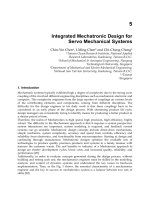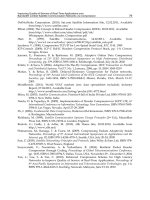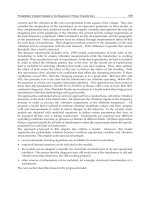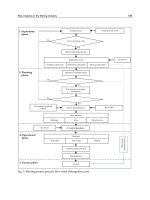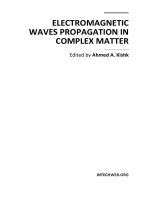Electromagnetic Waves Propagation in Complex Matter Part 7 pptx
Bạn đang xem bản rút gọn của tài liệu. Xem và tải ngay bản đầy đủ của tài liệu tại đây (1.13 MB, 20 trang )
Quasi-planar Chiral Materials for Microwave Frequencies
107
curing temperature. We observe that the rotation angle decreases when the frequency
increases, which means that the resonance frequency is below the measurement range. As it
can be expected, the rotation angle increases with the number density of inclusions and with
the sample width, following a nearly linear relation. Similar behavior has been found in
other experiments with helices (Brewitt-Taylor et al., 1999) or cranks (Molina-Cuberos et al.,
2005).
Fig. 11. Rotation of the polarization plane for a plane wave normally incident over a planar
array of gammadions (Fig. 10), and for different supporting boards: free space (magenta),
FR4 (blue), unlossy CER-10 (green) and lossy CER-10 (red). The result is the same in front
and back incidence.
4.2 Planar distributions
We have modeled, using CST Studio Suite
TM
2009, the rotation of the polarization plane, for
a plane wave normally incident over a plane structure, similar, at a different scale, to the one
studied by Papakostas et al. (2003). Our structure is also an array of gammadions (Fig. 10)
that, in this case, presents resonance in the microwave band. The rotation has been
determined assuming different properties of the board that supports the array: first
assuming it has the same properties as vacuum, second, a typical material on PC Boards
(FR4,
34.
r
) and, finally, a high permittivity material, like Taconic CER-10 (
10
r
), all
present in CST Studio Suite
TM
2009 library. The results are shown in Fig. 11. In the first case
(vacuum), the structure is symmetrical in a normal axis, so it is not chiral in 3D (the specular
Electromagnetic Waves Propagation in Complex Matter
108
image is coincident with the result of a rotation around a longitudinal axis), so there is no
electromagnetic activity (no rotation). When taking into account the effect of the board, the
structure becomes 3D chiral. In this case, we observe electromagnetic activity, which
increases when the properties of the board (permittivity or losses) are higher, i.e., when
there is more difference with free space.
Fig. 12. Two examples of the rotation angle produced by a periodical lattice of metallic
cranks formed by three equal size segments (5 mm) cranks for left-handed cranks with a
separation of 6.9 mm (up) and right-handed cranks with a separation of 9.1 mm (down).
[Reprinted from García-Collado et al. (2010) © 2010 IEEE]
4.3 Quasi-planar distributions (cranks)
Fig. 12 shows two examples of the rotation angle produced by periodical lattices of cranks as
the one represented in Fig. 3. Both plots correspond to the cranks with the same total length,
15 mm, and different handedness and separation. It can be observed that the sign of the
rotation produced by a periodical lattice of cranks depends on the handedness of the
elements, as it has been observed in chiral composites formed by randomly oriented
elements. In a periodical lattice, the distance of the elements also affects to the characteristic
frequencies. In this case, the resonance frequency decreases from 10.4 GHz (up) to 9.8 GHz
when the crank separation distance changes from 6.9 mm to 9.1 mm. We do not observe any
non-reciprocal effect, i.e. the rotation angle is the same if the wave is incident in the opposite
direction.
These results are compared with other ones, obtained by means of time-domain modeling of
the same structure, using MeFisTo-3D. In this case, the four cranks of each gammadion are
separated 6 mm, while there are 4 mm of distance between two consecutive gammadions.
The results are showed in Fig. 13, showing a good agreement between both measures.
Quasi-planar Chiral Materials for Microwave Frequencies
109
Fig. 13. Rotation of the polarization angle for a plane wave normally incident over a quasi-
planar periodic array of right-handed cranks as shown in Figs. 3 and 6: numerical (Num)
and experimental (Exp) results. 1 and 2 represent the two possible directions of the
propagation wave (incident from front and back side, respectively).
Finally, we propose a different distribution of cranks (Fig. 14). In this case, there is a higher
concentration of cranks in the same surface, so it is expected to obtain a higher gyrotropy
too. That distribution is also geometrically reciprocal.
Fig. 14. MEFiSTo
TM
model of a condensed array of cranks. Each crank is composed by two
arms, 3mm long, one in each side of the board (1.5 mm of thickness), plus a via connecting
both.
Electromagnetic Waves Propagation in Complex Matter
110
The electromagnetic behavior of such distribution has been modeled using MEFiSTo
TM
: we
have obtained the rotation of the polarization plane after a normal transmission through
that array. The angle of rotation does not depend on the initial polarization of the incident
wave (that is, the medium behaves like a biisotropic one, at least in a transversal axis), and it
is the same in the two directions of propagation (reciprocal). The result is shown in Fig. 15.
It is worth to mention the couple of discontinuities between -90º and 90º that may be
observed in the figure. Such discontinuities are common to most of the distributions we
have studied: when we see only one of them (Fig. 12 and Fig. 13) it is caused by the
limitations in broadband that suffer our experimental bank. At the same time, other authors
(Zhou et al., 2009) find a similar behavior in frequency, being usually assumed to
correspond to resonance frequencies. We believe this behavior does not correspond to a real
jump in the rotation frequency, but it is a consequence of the measurement procedure, in
which the result is normalized between -90º and 90º. If we normalize between 0 y 180º the
result in Fig. 15 would be as shown in Fig. 16.
More important: if we study the propagation through several layers of our material, we may
draw the rotation angle like in Fig. 17. There, it is demonstrated that the response is lineal
(the rotation angle is proportional to the width of the material (number of layers) and, then,
the resonance frequency does not depend on the number of layers.
Fig. 15. Rotation of the polarization plane for a plane wave normally incident over a
condensed array of cranks (Fig. 14), normalizing between -90º and 90º
Quasi-planar Chiral Materials for Microwave Frequencies
111
Fig. 16. Rotation of the polarization plane for a plane wave normally incident over a
condensed array of cranks like represented in Fig. 14, normalizing between 0º and 180º
Fig. 17. Rotation of the polarization angle for a wave linearly polarized, incident over a
condensed distribution of cranks like shown in Fig. 14, for one (blue line), two (red) or three
(green) parallel boards. [Reprinted from Barba et al. (2009) © 2009 IEEE]
Electromagnetic Waves Propagation in Complex Matter
112
The chiral material for waveguide experiments was built as described in section 3. However,
there are some inherent restrictions in the design due to the limited size of the sample. The
radius of the waveguide is similar, in magnitude, to the one of the crank, which strongly
limits the number of elements that can be placed on a one-layer distribution, without contact
among the elements. Fig. 18 shows two examples produced by four metallic cranks in a
foam host medium (left) and eight cranks (right). We have experimentally observed, as it
could be deduced by considering symmetry reasons, that other distributions of cranks do
not present an isotropic behavior.
In order to analyze the response of a single cell, we have measured the rotation angle after a
transmission through a group of four cranks, making use of the waveguide setup described
in section 3.Fig. 19 shows the rotation angle for cranks formed by equal-size segments, with
a total length L ranging from 13.5 mm to 18 mm (Fig. 18). For example, for L = 15 mm, a
clear resonance frequency is observed at f
0
= 10.08 GHz, the angle is negative below f
0
and
positive above f
0
. It can be also observed that resonance frequency decreases when the
length of the cranks increases, which is in agreement with similar observations found in
composites formed by randomly oriented helices (Busse et al., 1999) or cranks (Molina-
Cuberos et al., 2009). The experimental resonance frequencies are 8.24 GHz, 9.04 GHz, 10.1
GHz and 11.7 GHz, very close to a relation 2
L
.
We have previously checked that the rotation angle does not depend on the relative
orientation between cranks and incident wave, i.e. the sample presents an isotropic and
homogeneous behavior. This fact does not occur in other configurations with odd number of
cranks or with less symmetry properties. In the last case, the observed gyrotropy is a non-
chiral effect and other electromagnetic effects, if any, hide the rotation due to chirality. In
general we have found isotropic behavior when the sample presents symmetry under 45
degrees rotation, although other rotation symmetries are not ruled out.
Fig. 18. Cylindrical samples used for the experimental determination of chiral effect by using
a waveguide setup.
5. Conclusion
We have studied different periodical distributions, planar and quasi-planar, which show
chiral behavior. We have observed that even when using a planar distribution, its
electromagnetic activity comes from its 3D geometry. The rotation will be stronger, then, if
we enhance this 3D characteristic. Two possibilities have been studied: some researchers
prefer to use multilayered distributions of planar geometries, with a twist between adjacent
layers, while we prefer to use two face metallization, with vias connecting both faces of
Quasi-planar Chiral Materials for Microwave Frequencies
113
every board: that may present the advantage of obtaining similar electromagnetic activity,
combined with thinner structures. The results we have obtained, both using numerical time-
domain modeling and experimental measurements seem to support our claim
Fig. 19. Rotation angle produced by the samples composed by four cranks in foam (Fig. 18),
as a function of the size of the cranks.
6. References
Alú, A.; Bilotti, F. & Vegni, L. (2003), Generalized transmission line equations for
bianisotropic materials,
IEEE Transactions on Microwave Theory and Techniques. Vol.
51, No. 11 (November 2003), pp. 3134–3141. ISSN 0018-9480.
Barba, I; Cabeceira, A.C.L.; Gómez, A. & Represa, J. (2009), Chiral Media Based on Printed
Circuit Board Technology: A Numerical Time-Domain Approach,
IEEE Transactions
on Magnetics
. Vol. 45, No. 3 (March 2009), pp. 1170-1173. ISSN 0018-9464.
Bahr, A.J. & Clausing, K.R. (1994). An approximate model for artificial chiral material,
IEEE
Transactions on Antennas and Propagation
. Vol. 42, No. 12 (December 1994), pp. 1592-
1599, ISSN 0018-926X.
Balanis, C.A. (1989).
Advanced Engineering Electromagnetics, John Wiley & Sons, ISBN 0-471-
62194-3, New York, NY, USA.
Brewitt-Taylor, C.R.; Lederer, P.G.; Smith F.C. & Haq S. (1999). Measurements and
prediction of helix-loaded chiral composites,
IEEE Transactions on Antennas and
Propagation.
Vol. 47, No. 4 (April 1999), pp. 692-700, ISSN 0018-926X.
Cloete, J.H.; Bingle, M. & Davidson, D.B. (2001). The Role of Chirality in Syntehtic
Microwave Absorbers,
International Journal of Electronics and Communications, Vol.
55, No. 4 (April 2001), pp. 233-239, ISSN 1434-8411.
Electromagnetic Waves Propagation in Complex Matter
114
Condon, E.U. (1937). Theories of optical rotatory power, Reviews of Modern Physics, Vol. 9,
(October 1937), pp. 432-457, ISSN 0064-6861.
Demir, V.; Elsherbeni, A.Z. & Arvas, E (2005) FDTD formulation for dispersive chiral media
using the Z transform method,
IEEE Transactions on Antennas and Propagation, Vol.
53, No. 10 (October 2005), pp. 3374–3384, ISSN 0018-926X
García-Collado A.J.; Molina-Cuberos, G.J.; Margineda, J.; Núñez, M.J. & Martín, E. (2010).
Isotropic and homogeneous behavior of chiral media based on periodical inclusions
of cranks,
IEEE Microwaves and Wireless Components Letters, Vol. 20, No 3, pp. 176-
177, (March 2010), ISSN 1531-1309.
Gómez A.; Lakhtakia, A.; Margineda, J.; Molina-Cuberos, G.J; Núñez, M.J.; Saiz Ipiña, J.A, &
Vegas A. (2008). Full-Wave hybrid technique for 3-D isotropic-chiral-material
discontinuities in rectangular waveguides: Theory and Experiment,
IEEE
Transactions on Microwave Theory and Techniques,
Vol. 56, No. 12 (December 2008),
pp. 2815-2824, ISSN 0018-9480.
Gómez, A.; Lakhtakia, A.; Vegas, A. & Solano, M.A. (2010) Hybrid technique for analyzing
metallic waveguides containing isotropic chiral materials,
IET Microwaves, Antennas
& Propagation
, Vol. 4, No. 3 (March 2010), pp. 305-315, ISSN 1751-8725.
González-García, S.; Villó-Pérez, I.; Gómez-Martín, R. & García-Olmedo, B. (1998) Extension
of Berenger’s PML for bi-isotropic media,
IEEE Microwave and Guided Wave Letters,
Vol. 8, No. 9 (September 1998), pp. 297–299, ISSN 1051-8207
Kopyt, P.; Damian, R.; Celuch, M. & Ciobanu, R. (2010) Dielectric properties of chiral
honeycombs – Modelling and experiment,
Composites Science and Technology, Vol.
70, No. 7 (July 2010), pp. 1080-1088, ISSN 0266-3538.
Kuwata-Gonokami, M.; Saito, N.; Ino Y.; Kauranen, M.; Jefimovs, K.; Vallius, T.; Turunen, J.
& Svirko, Y. (2005). Giant Optical Activity in Quasi-Two-Dimensional Planar
Nanostructures,
Physical Review Letters, Vol. 95, No. 22 (November 2005), pp.
227401, ISSN 0031-9007.
Lakhtakia, A.; Varadan, V.V. & Varadan, V.K. (1988) Radiation by a straight thin-wire
antenna embedded in an isotropic chiral medium,
IEEE Transactions on
Electromagnetic Compatibility
, Vol. 30, No. 1 (February 1988), pp. 84–87, ISSN 0018-
9375.
Le Guennec, P. (2000a) Two-dimensional theory of chirality. I. Absolute chirality,
Journal of
Mathematical Physics
, Vol. 41, No. 9 (September 2000), pp. 5954-5985, ISSN 0022-
2488.
Le Guennec, P. (2000a) Two-dimensional theory of chirality. I. Relative chirality and the
chirality of complex fields,
Journal of Mathematical Physics, Vol. 41, No. 9 (September
2000), pp. 5986-6006, ISSN 0022-2488.
Lindell, I.V.; Tretyakov, S.A. & Oksanen, M.I. (1992) Conductor-backed Tellegen slab as
twist polarizer,
Electronic Letters, Vol. 28, No. 3 (30
th
January 1992), pp. 281–282,
ISSN 0013-5194.
Lindell, I.V.; Sihvola, A.H.; Tretyakov, S.A. & Viitanen, A.J. (1994).
Electromagnetic Waves on
Chiral and Bi-Isotropic Media
, Artech House, ISBN 0-89006-684-1, Norwood, MA,
USA.
Lindman, K.F. (1920) Uber eine durch ein isotropes system von spiralformigen resonatoren
erzeugte rotationspolarisation der elektromagnetischen wellen,
Annalen der Physik,
Vol. 368. No. 23 (May 1920), pp. 621–644, ISSN 1521-3889.
Quasi-planar Chiral Materials for Microwave Frequencies
115
Marqués, R.; Jelinek, J. & Mesa, F. (2007). Negative refraction from balanced quasi-planar
chiral inclusions,
Microwave and Optical technology Letters, Vol. 49, No. 10 (October
2007), pp. 2606-2609, ISSN 0895-2477.
Molina-Cuberos, G.J.; García-Collado A.J.; Margineda, J.; Núñez, M.J. & Martín, E. (2009).
Electromagnetic Activity of Chiral Media Based on Crank Inclusions,
IEEE
Microwave and Wireless Components Letters
. Vol. 19, No. 5 (May 2009), pp. 278-280.
ISSN 1531–1309.
Muñoz, J.; Rojo, M. Parreño, A. & Margineda J. (1998). Automatic measurement of
permittivity and permeability at microwave frequencies using normal and oblique
free-wave incidence with focused beam.
IEEE Transactions on Instrumentation and
Measurement,
Vol 47, No. 4 (August 1998), pp. 886-892, ISSN 0018-9456.
Papakostas, A.; Potts, A.; Bagnall, D.M.; Prosvirnin, S.L.; Coles, H.J. & Zheludev, N.I. (2003).
Optical Manifestations of Planar Chirality,
Physical Review Letters, Vol. 90, No. 10
(March 2003), pp. 107404, ISSN 0031-9007.
Pendry, J.B. (2004). A Chiral Route to Negative Refraction,
Science, Vol. 306, No. 5700
(November 2004), pp. 1353-1355, ISSN 0036-8075.
Pereda, J.A.; Grande, A.; González, O. & Vegas, A. (2006). FDTD Modeling of Chiral Media
by Using the Mobius Transformation Technique,
IEEE Antennas and Wireless
Propagation Techniques
, Vol. 5, No. 1 (December 2006), pp. 327–330, ISSN 1536-1225.
Pitarch, J.; Catalá-Civera, J.; Peñaranda-Foiz, F. & Solano, M.A. (2007). Efficient modal
analysis of bianisotropic waveguides by the Coupled Mode Method,
IEEE
Transactions on Microwave Theory and Techniques,
Vol. 55, No. 1 (January 2007), ISSN
0018-9480.
Plum, E.; Fedotov, V.A.; Schwanecke, A.S.; Zheludev, N.I. & Chen, Y. (2007). Giant optical
gyrotropy due to electromagnetic coupling,
Applied Physics Letters, Vol. 90, No. 22
(May 2007), pp. 223113, ISSN 0003-6951.
Plum, E.; Zhou, J.; Dong J.; Fedotov, V.A.; Koschny, T.; Soukoulis, C.M. & Zheludev, N.I.
(2009). Metamaterial with negative index due to chirality, P
hysical Review B, Vol. 79,
No. 3 (January 2009), pp. 035407, ISSN 1098-0121.
Rogacheva, A. V.; Fedotov, V.A.; Schwanecke, A.S. & Zheludev, N.I. (2006). Giant
Gyrotropy due to Electromagnetic-Field Coupling in a Bilayered Chiral Structure,
Physical Review Letters, Vol. 97, No. 17 (October 2006), pp. 177401, ISSN 0031-9007.
Schwanecke, A.S.; Krasavin, A.; Bagnall, D.M.; Potts, A.; Zayats, A.V. & Zheludev, N.I.
(2003). Broken Time Reversal of Light Interaction with Planar Chiral
Nanostructures,
Physical Review Letters, Vol. 91, No. 24 (December 2003), pp.
247404, ISSN 0031-9007.
Tretyakov, S.A.; Sihvola, A.H. & Jylhä, L. (2005). Backward-wave regime and negative
refraction in chiral composites,
Photonics and Nanostructures: Fundamentals and
Applications
, Vol. 3, No. 2-3 (December 2005), pp. 107–115, ISSN 1569-4410.
Varadan, V.K.; Varadan, V.V. & Lakhtakia, A. (1987). On the possibility of designing
antireflection coatings using chiral composites,
Journal of Wave Matter Interaction,
Vol. 2 , No. 1 (January 1987), pp. 71–81, ISSN 0887-0586.
Viitanen, A.J. & Lindell, I.V. (1998). Chiral slab polarization transformer for aperture
antennas,
IEEE Transactions on Antennas and Propagation, Vol. 46 , No. 9 (September
1998), pp. 1395–1397, ISSN 0018-926X.
Electromagnetic Waves Propagation in Complex Matter
116
Xu, Y. & Bosisio, R.G. (21995) An efficient method for study of general bi-anisotropic
waveguides,
IEEE Transactions on Microwave Theory and Techniques, Vol. 43, No. 4
(April 1995), pp. 873–879, ISSN 0018-9480.
Zhou, J.; Dong, J.; Wang, W.; Koschny, T.; Kafesaki, M. & Soukoulis, C.M. (2009). Negative
refractive index due to chirality, P
hysical Review B, Vol. 79, No. 12 (March 2009), pp.
121104, ISSN 1098-0121.
5
Electromagnetic Waves in
Contaminated Soils
Arvin Farid
1
, Akram N. Alshawabkeh
2
and Carey M. Rappaport
2
1
Boise State University,
2
Northeastern University
USA
1. Introduction
Soil is a complex, potentially heterogeneous, lossy, and dispersive medium. Modeling the
propagation and scattering of electromagnetic (EM) waves in soil is, hence, more
challenging than in air or in other less complex media. This chapter will explain
fundamentals of the numerical modeling of EM wave propagation and scattering in soil
through solving Maxwell’s equations using a finite difference time domain (FDTD) method.
The chapter will explain how: (i) the lossy and dispersive soil medium (in both dry and fully
water-saturated conditions), (ii) a fourth phase (anomaly), (iii) two different types of
transmitting antennae (a monopole and a dipole), and (iv) required absorbing boundary
conditions can numerically be modeled. This is described through two examples that
simulate the detection of DNAPL (dense nonaqueous-phase liquid) contamination in soil
using Cross-well radar (CWR). CWR —otherwise known as cross-borehole GPR (ground
penetrating radar)—modality was selected to eliminate the need for simulation of the
roughness of the soil-air interface. The two examples demonstrate the scattering effect of a
dielectric anomaly (representing a DNAPL pool) on the EM wave propagation through soil.
The objective behind selecting these two examples is twofold: (i) explanation of the details
and challenges of numerical modeling of EM wave propagation and scattering through soil
for an actual problem (in this case, DNAPL detection), and (ii) demonstration of the
feasibility of using EM waves for this actual detection problem.
In addition, the results of an experimental simulation of Example 1 (the case with the
monopole antenna) will be analyzed and discussed. The results of the corresponding
numerically simulated example will then be compared and validated against the above-
mentioned experimental results. A conclusion section will close the chapter.
Before explaining the numerical modeling and its challenges, some background about
DNAPLs and their detection technologies, including the CWR method, is explained in the
following section.
2. Background
Cross-well radar (CWR), otherwise known as cross-borehole ground-penetrating radar
(cross-borehole GPR) is a minimally invasive method that uses high frequency
electromagnetic (EM) waves transmitted and received by antennae in the subsurface to
image objects of contrasting dielectric properties. In order to assess the feasibility of using
Electromagnetic Waves Propagation in Complex Matter
118
CWR for detection of dense nonaqueous-phase liquid (DNAPL) pools in deeper layers, this
technique should be numerically simulated and evaluated. CWR is more appropriate for
deep investigations. For near-surface sensing such as bridge-deck health monitoring,
methods such as GPR are more appropriate (Belli et al., 2009 and 2009a). GPR studies
require addressing the scattering due to the rough soil-air interface in the forward model as
well as through the inversion process (Firoozabadi et al., 2007).This chapter describes a
numerical modeling approach to Maxwell's equations using a finite difference time domain
(FDTD) solution with both monopole and dipole antennae to simulate the scattering and
propagation of EM waves in DNAPL-contaminated media. An FDTD code, originally
developed for detection of mines using two-dimensional (2D) surface-reflection ground-
penetrating radar (GPR) through non-dispersive media, was revised and upgraded for
three-dimensional (3D) cross-borehole wave propagation in heterogeneous soils. The three
dimensional FDTD code was enhanced to accommodate dispersive media and was used to
model EM wave propagation in heterogeneous soils. This chapter describes the effect of the
radiation patterns of two different antennae on propagation and scattering of EM waves
through the soil subsurface and its potential for detection of DNAPL pools. In order to
evaluate the feasibility of using the CWR method to detect DNAPL pools, illustrative
examples with and without the presence of the DNAPL pool were analyzed. The results
show considerable diagnostic potential to detect contaminated zones with DNAPLs using
EM waves through CWR.
DNAPLs are separate-phase hydrocarbon liquids denser than water, such as chlorinated
solvents (tetrachloroethene (PCE) and trichloroethylene (TCE)), wood preservatives, coal tar
wastes, and pesticides. DNAPLs may not usually be found as a free phase in soil cores or
accumulated in monitoring wells. Based on this lack of observable evidence of DNAPL pools,
investigators may conclude that no DNAPL is present, when it may be present in substantial
quantities at residual saturation as large as 70% to 80% of the total porosity (ITRC, 2000).
There are varieties of invasive techniques to detect DNAPLs such as direct push probe
techniques (e.g., direct soil sampling or indirect sampling such as negative ion sensor) and
use of in situ tracers (e.g., PITT, or partitioning interwell tracer test), excavating test pits, and
groundwater profiling. Most invasive techniques just provide point-sources of information
and may help the DNAPL pool to spread through the substantial number of required
boreholes and excavated trenches, while noninvasive geophysical techniques noninvasively
or minimally invasively detect DNAPLs. They can use different types of waves (e.g.,
electromagnetic, acoustic, etc.) to indirectly reconstruct images to characterize or detect
anomalies as DNAPLs within heterogeneous media. These methods are minimally invasive
techniques that discriminate the contrast between local physical properties of the
background and target to produce images of the subsurface.
Cross-well P-wave transmission at 90 kHz was used in a sand pack before and after
introducing NAPLs by Geller et al. (2000). The results indicated that small NAPL saturations
may be more easily detected with amplitude than with travel time data, but the
relationships between the amplitude changes and NAPL saturation may be more complex
than those for velocity.
Cross-hole complex resistivity was also applied to a contaminated vadose zone by Grimm
and Olhoeft (2004) to predict the general distribution of DNAPLs at parts per thousand
concentrations, specifically widespread near-surface contamination and in the vadose zone
immediately underneath the source.
Complex resistivity (CR) is a technique that so far has shown a potential in detecting
DNAPL pools (Blackhawk Geoservices Inc., 2008).
Electromagnetic Waves in Contaminated Soils
119
Smith-Rose (1993 & 1935) is among the earliest scientists who studied the dielectric
permittivity of different soils. Some physical properties of a typical DNAPL (i.e., PCE) are
compared with those of different soils, water, and air in Table 1.
As seen, dielectric permittivity and effective (= DC + alternating field) electrical conductivity
of PCE are lower than those of water and relatively similar to air or some dry soils. Thus, a
PCE-contaminated region of the saturated zone should provide a contrast with a similar
magnitude of the unsaturated-saturated zone interface (water table). The values of dielectric
permittivity for water and soil are dispersive (depend on frequency), but most DNAPLs are
nonpolar molecules with minimal frequency dependence and therefore with almost no
dispersive characteristics. In frequencies greater than 10 MHz and less than 1 GHz, the
dielectric permittivity is controlled by the polarization of individual water molecules and is
therefore dependent on moisture content (Binley et al., 2001). Dielectric permittivity in the
lower MHz range of frequency (< 10 MHz) depends on particle shape and mineralogy,
electrolyte type and concentration, particle orientation, and soil electrolyte interaction (Rinaldi
& Francisca, 1999). In the upper MHz range of frequency (10 to 1000 MHz), the real part of
dielectric permittivity is affected by the polar contribution of bound and free water molecules
(Hoekstra & Doyle, 1971; Hoekstra & Delaney, 1974; Selig & Mansukhani, 1975; Dobson et al.,
1985; Hallikainen et al., 1985; and Arulanandan, 1964). Sachs and Spiegler (1964) presented a
model for dielectric permittivity of soil mixtures at different frequencies. This model is based
on an equivalent circuit for conductive particles in electrolytes and fitted in the dielectric plane
by adjustment of three parameters. Arulanandan and Smith (1973) explained some aspects of
dielectric dispersion based on the Sachs and Spiegler (1964) model in a frequency range from
10
6
to 10
8
Hz. Another model that explains the dispersion of the soil relative dielectric
permittivity, otherwise known as dielectric constant, was presented by Thevanayagham
(1995), which considers the effect of particle orientation relative to the electric field. Weedon
and Rappaport (1997) and Rappaport et al. (1999) presented a model to predict the dispersive
nature of the dielectric permittivity and electrical conductivity of soils, using a rational Z-
transform approximation function of the conductivity. This technique uses the values of
dielectric permittivity and electrical conductivity of the bulk mixture, and does not deal with
the components and their volumetric content. It is basically a technique to convert the bulk
values for the matrix to a form applicable to the FDTD method to take the dispersive nature of
the resultant mixture into account.
Material
Density ρ
(g/cm3)
Real Part of Dielectric Constant*
(ε
r
)
**** Effective Electrical
Conductivity σ
e
(1/Ω.m)
f = 100 MHz f = 1.5 GHz f = 100 MHz
f = 1.5 GHz
PCE 1.62 2.28 2.28 2.63 × 10
-6
1.52 × 10
-4
Water** 1.00 78 77.14 2.2 × 10
-3
0.509
Dry Sand 1.30 2.55 2.55 1.8 × 10
-4
2.1 × 10
-3
Soil*** 1.60 6.912 6.50 0.1329 0.1
* Dielectric constant is also known as relative dielectric permittivity
** Pure water
*** 20% moist Bosnian clay loam
**** Effective electrical conductivity (σ
e
) = Static or DC conductivity (σ
s
) + Alternating field conductivity (σ
a
)
Table 1. Physical Properties of PCE, Water and Soil at 25
o
C (Degrees Celsius)
(Brewster & Annan, 1994), (Von Hippel, 1953), (Hipp, 1974), (Weedon & Rappaport, 1997),
(Rappaport et al., 1999).
Electromagnetic Waves Propagation in Complex Matter
120
The loss (attenuation) in soil is a function of a variety of factors such as soil type and
mineralogy, moisture content, electrical conductivity, and frequency. Higher frequency EM
waves attenuate faster. In other words, soil acts as a low-pass filter. However, higher
frequency EM waves provide higher image resolution. There is a tradeoff between the
penetration depth and image resolution. Therefore, feasibility of the CWR to detect an
average size DNAPL pool using proper frequency range is the first step to detection, which
is the main goal of this chapter.
Soil, water, and DNAPL mixed at DNAPL saturations of 0% to 50% (i.e., water saturation of
50% to 100% below water table; i.e., no air) have been evaluated by Ajo-Franklin et al. (2004)
to have a dielectric constant of 9 (50% water saturation soil with 50% DNAPL saturation) to
24 (fully (100%) water-saturated soil with 0% DNAPL saturation). These values are different
from the dielectric constant of pure DNAPL (ε’ ≈ 2.3) and vary based on porosity and degree
of DNAPL saturation as the result of mixture.
There are some expected limitations to using CWR to detect DNAPLs in soil and
groundwater such as: (a) use of CWR to detect DNAPLS may not perform as well in dry or
partially saturated zones as in water saturated zones, due to the weaker contrast in
electromagnetic properties of DNAPLs and dry soils compared to the one between DNAPLs
and water saturated soils, (b) the concentration (or contaminant saturation) must be fairly
high, which makes the detection of DNAPLs using CWR often limited to identifying
DNAPL pool sources (high DNAPL saturation) and not plumes, and (c) the spacing between
the wells strongly influences the effectiveness of CWR (as the separation between
transmitting and receiving antennae increases, the radar wave amplitude attenuates, which
creates greater difficulty in distinguishing the wave from background noises) (ITRC, 2000).
Therefore, in this chapter a simple case of DNAPL dominantly replacing water in the pores
(DNAPL saturation of 80% to 100%) is simulated numerically. Based on Bruggeman-Hanai-
Sen (BHS) model (Sen et al., 1981), due to low dielectric constant of soil grains (≈ 5, (Ajo-
Franklin et al., 2004)), the bulk dielectric constant of the soil mixture within the DNAPL pool
(close to 100% DNAPL saturation) values between 2.3 and 5. Hence, for comparison, acrylic
was selected as the dielectric object of
’ ≈ 2.6 (Weast, 1974) since it has been used in another
experimental work by the authors (Farid et al., 2006). This strong contrast in dielectric
constant between the dielectric constant of the acrylic (≈ 2.6) and water-saturated soils (≈ 15 -
25) makes detecting the scatterer in the saturated soil using radar-based geophysical
methods feasible.
The U.S. Geological Survey used 500-MHz surface GPR among other methods to monitor
the location and migration of the subsequent plume (Sneddon et al., 2000).
Bradford and Wu (2007) tested 3D multi-fold GPR on a small scale controlled DNAPL
release to detect contaminated soil with demonstrated success.
While GPR is the least invasive radar-based method, it is not a practical one for deep
investigations. Cross-Well Radar (CWR), otherwise known as cross-borehole GPR, may be a
more effective method for deep contaminant detection. CWR is a method that uses EM wave
transmission measurement across borehole antennae as opposed to reflection measurements
used in surface-reflection imaging methods, such as GPR. CWR overcomes some of depth
limitations of surface-reflection imaging GPR. CWR uses antennae that are lowered into
sampling wells with cables. Radar waves are emitted from a transmitting antenna in one
well and propagate through the ground to a receiving antenna in a second well. The
subsurface geology and pore fluids scatter, refract, or reflect the waves. DNAPL pools also
provide dielectric permittivity and electrical conductivity contrasts within relative moist
Electromagnetic Waves in Contaminated Soils
121
soils, which in turn, cause refractions or reflections on EM waves. These scatterings and
reflections make DNAPLs amenable to detection by radar. Other than the magnitude of the
scattering field, phase, and hence, travel time can also be used for other techniques such as
travel time tomography to reconstruct images of the background medium and anomalies
within the medium.
Success of radar-based methods as well as any other detection technique depends on the
strength of the contrast in properties of the background and scatterer (e.g., DNAPLs,
moisture). Dielectric permittivity and electrical conductivity are the main parameters
controlling such differences for radar-based techniques.
CWR relies on a one-way travel time whereas the surface-reflection imaging GPR relies on
the 2-way travel time. Therefore, the effective antenna separation of CWR can be twice as far
as the penetration depth of surface-reflection GPR, theoretically. GPR antennae are designed
to be relatively impedance-matched to the ground, and the reflection coefficient at the air-
soil interface is close to unity leading to the potential for strong internal reflection. However,
there is still the disadvantage of reflections at the air-soil interface, which reduces the
amount of received waves reflected by the underground objects. The performance of
detection using CWR is highly dependent on seasonal conditions, in particular soil moisture
(Daniels et al., 1992). Soil mineral composition and physicochemical properties also
influence radar signals. For example, clays tend to attenuate these signals and therefore may
limit the skin depth and effectiveness of the method (Anderson & Peltola, 1996).
Considering these limiting factors, feasibility of the technique for DNAPL detection should
be evaluated by simulating implementation of ultra-wideband CWR. Further understanding
of the behavior of 3D EM waves in soil is necessary for the future implementation and
feasibility evaluation of CWR for detecting DNAPLs. To achieve this goal, the detection
technique using monopole and dipole antennae is modeled numerically in the time domain
using an FDTD technique. A critical issue addressed in this research, by direct simulation of
the antennae, is the wave interaction at the antenna/soil interface. The technique models the
transmitting antenna but measures the electrical field at all grid points on any desired cross-
sectional or depth slice (instead of modeling receiving antennae). This is equivalent to
having hundreds of receiving antennae in soil, which is not practical. In practical techniques
such as cross-well tomography, few antennae are installed and used alternatively as
transmitters or receivers to collect data in a multiple-depth, multiple-location manner, and
the outcome is used for inversion and image processing techniques (the authors are working
on different aspects of cross-well tomography and results will be published in the future).
Obviously, the simulation technique presented in this chapter is used only for preliminary
evaluation of the feasibility of detecting DNAPL pools using CWR. The outcome can also be
used as a forward modeling for future inversion techniques.
Besides, another goal of this chapter is to evaluate the feasibility of DNAPL detection and to
investigate if there are points with strong signature by the object on the scattered field, not
to discuss inverse modeling. Therefore, receiving antennae are not modeled. The results
model no noise. Nevertheless, comparison between the values of the scattered field (by the
target) with those of the incident field will provide helpful information that can lead to the
critical noise/signal ratio, even without applying any noise. This is discussed in more detail
in the following sections. Experimental works are being conducted to evaluate typical levels
of noise, compare them to the levels derived from this technique, then apply the noise to the
simulation and reevaluate the feasibility (Farid et al., 2006).
Electromagnetic Waves Propagation in Complex Matter
122
3. FTDT modeling of maxwell’s equations
Finite Difference Time Domain (FDTD) is a relatively powerful and very popular method
because of its simplicity and despite its instability problems. Therefore, a 3D FDTD code
was developed and used to simulate the antenna performance, coupling, and interactions in
soils. The FDTD technique was originally introduced by Yee (1966) and is based on time and
spatial discretization of Maxwell’s equations to obtain solutions for the EM field in the time
domain. The technique is numerically implemented by continuously sampling the
electromagnetic field over the wave propagation medium discretized into a grid. The
differential form of Maxwell’s equations in the time domain is as follows (Grant & Philips,
1990; Sheriff, 1989; and Balanis, 1989).
B
EJ
m
t
(1)
D
HJ
e
t
(2)
D
e
(3)
B
m
(4)
along with the constitutive relations,
BH
(5)
DE
(6)
JE
ee
(7)
JH
m
m
(8)
where
E is the electric field density, H is the magnetic field intensity, D is the electric
displacement or electric flux density,
B is the magnetic flux density, J
e
is the impressed
(source) electric current density,
J
m
is the impressed (source) magnetic conductive current
density,
e
is the electrical conductivity,
m
is the magnetic resistivity, ε is the dielectric
permittivity,
is the magnetic permeability, ρ
e
is the electric charge density, and ρ
m
is the
(monopole) magnetic charge density. All of the field parameters,
E, H, B, D, J
e
, and J
m
are
assumed to be functions of position and time t, while material parameters
, , and are
functions of position and may be dispersive functions of frequency (and thus, through the
Fourier Transform, also of time). Note that the usual multiplicative constitutive relations are
written as convolutions for dispersive soil media. Equations (1) through (4) can be also
written in integral forms. These four partial differential equations are discretized in a 3D
rectangular grid, using a central-difference approximation of two consecutive values for the
field components in both space and time. Due to the nature of electric and magnetic fields
(e.g., coil loops), these two cannot be located at the same spatial location. In the
Electromagnetic Waves in Contaminated Soils
123
discretization process, electric and magnetic field components are assigned to the edges of
complementary interlocking cubical meshes. Thus, half-space indices are introduced for
different field components. Besides, half time steps are introduced to perform the finite
difference computation of
E based on H and vice versa. Spatial and time steps are
respectively represented by the lower indices (i, j, k) and the upper index (n). Some details
of the simulation process are explained in the following. Fig. 1 helps to better understand
this staggered time and space grid. As seen in the superscripts in the figure, there is ½ time
step difference between
E and H. Due to the central difference approximation technique in
time,
H is present at both the (n + ½)
th
and (n - ½)
th
time steps in the equations along with E
only at the n
th
time step.
Fig. 1. 3D interlocking FDTD cell (Yee cell, 1966).
3.1 Advantages and limitations
The most advantageous characteristic of the FDTD method is its simplicity. Solving
Maxwell’s equations using FDTD is a simple iterative procedure. However, there are several
limitations to the numerical implementation of the FDTD technique through the above-
mentioned difference equations. These limitations have been and are subject of research.
Some of these challenging limitations impose restrictions on the grid size and time step
increments that affect stability and accuracy of the method (Kunz & Luebbers, 1993).
One fundamental restriction requires the longest side of the grid cell to be much shorter
than the shortest wavelength of the wave within the cell. A very common restriction
assumed in practice is
/ 10, where
is the shortest appreciable wavelength in the excitation
signal. This constraint is imposed by both sampling limitation and grid dispersion errors
(Kosmas, 2006).
The second restriction develops from the scale and geometry of the problem. The method
uses a uniform grid to model small antennae along with a large soil medium with or
without contrasting objects. Accordingly, the geometry imposes challenging limitations,
especially in computation cost. For example, in the case of a DNAPL contaminated site,
dimensions of the background in horizontal directions may be of the order of tens of meters
by tens of meters in the XY-plane, while the antenna thickness may be of the order of
millimeters to centimeters. This requires solving a large uniform grid with a small grid-cell
size in the X and Y directions. At the same time, a small vertical (Z-direction) cell size is
Electromagnetic Waves Propagation in Complex Matter
124
required to account for thin DNAPL pools. One way to solve this problem is by using a non-
uniform grid, which adds more difficulties to the task of satisfying stability conditions (e.g.,
Courant condition).
The third limitation is the time-step restriction required to satisfy the Courant condition. The
Courant condition restricts time increments to a range in which waves do not travel too far
in each time increment, or:
1/2
2
,max
1
11
N
p
m
m
Vt
x
(9)
where N is the grid dimension, x
m
is the grid cell size in the m
th
direction, and V
p,max
is the
maximum wave phase velocity within the model. In a 3D case, Equation (9) will be written
in the following form:
1/2
222
,max
1111
p
Vt
xyz
(10)
In the case of N-dimensional isotropic cells, Equation (9) can be simplified to
,max
/1/
p
Vt N
(e.g., in a three dimensional case, N = 3, and
x =
y =
z =
), where
the left hand side is called the Courant number. Different cases have demonstrated that
using smaller values of
t does not necessarily improve the results. However, smaller values
for the Courant number may sometimes yield satisfactory results (Kosmas, 2006).
4. Modeling procedure
4.1 Modeling dispersive nature of soil
Soil is a complex medium to model because of its heterogeneous, lossy, and dispersive
nature. Accurate computation of the behavior of soil over a wideband of frequency requires
either several individual frequency domain calculations or a robust deconvolution of
E(t)
from
D(t) in the time domain (Rappaport et al., 1999). The convolutional approach to
modeling dispersion in soil approximates the frequency domain dispersive complex
dielectric constant with rational functions of jω and multiplies the constitutive relations by
the denominator. Then, the results are inverse-Fourier-transformed. This model is called the
Debye or Lorentz model (Kashiwa & Fukai, 1990; and Gandhi, 1993). Weedon and
Rappaport (1997) and Rappaport and Winton (1997) simplified the problem by modeling the
conductivity as a simple rational function of Z-transform. Modeling conductivity in terms of
the Z-transform variable (Z
-1
readily transforms to “time delays”) simplifies the process of
conversion of the generalized dispersive Ohm’s Law (
J(Z) = σ(Z) E(Z)) to the time domain.
To keep the simplicity of the FDTD method, Z-transform function of conductivity in the
time domain is given as (Weedon & Rappaport, 1997; and Rappaport et al., 1999):
12
01 2
1
1
J( )
()
E( )
1
Z
bbZ bZ
Z
Z
aZ
(11)
Using this function, both real and imaginary components of conductivity depend on the
sampling interval Δt and the coefficients of the rational Z-transform function (a
1
, b
0
, b
1
, and
Electromagnetic Waves in Contaminated Soils
125
b
2
). The real part of conductivity corresponds to measured conductivity, and the imaginary
part corresponds to real dielectric permittivity. Ampere’s law can be written in the Z-
domain as follows.
11
1(1)
H() E() ()E()
2
av
ZZ
ZZZZ
t
(12)
4.2 Absorbing boundary conditions
As in simulation of any diffusion application (e.g., heat transfer or water flow through
porous media), wave propagation through infinite media is practically modeled in a finite
grid. To model the infinity of the flow or wave propagation through the required infinite
media by the finite number of grid cells, appropriate boundary conditions are required. The
lattice termination absorbing boundary condition used in the FDTD code was based on the
second-order one-way wave propagation equation of Mur (1981) and adjusted for lossy soils
by Talbot and Rappaport (2000) using the rational function approximation of Equation (11).
4.3 Antenna and excitation
There are some factors that categorize the excitation, such as the source geometry, excitation
signal type, and hard or soft source of propagation.
Hard and Soft Sources: The code uses soft sources for all different antenna types. A hard
source specifies the total field at the excitation point. These types of sources are usually
avoided as they cause undesirable reflections at the source point. Alternatively, a soft source
specifies the additional field supplied above the existing background field at the source
point. The soft source can be specified at points on a radiating aperture, while hard sources
are used for current sources flowing along metal structures. In 2D cases, soft sources
propagate well, but extensive testing of 3D FDTD cases has shown difficulties involved in
propagation from a soft source unless the physical body of the antennae is modeled. This
paper uses soft sources for both monopole and dipole antenna cases of the following
sections.
Excitation Signal: A cosine-modulated Gaussian signal (Equation (13)) was used to excite
both antennae because of its simplicity and frequency content
2
0
0
)exp cos2 )
n
i, j, k
tt
E( E ( πft
W
(13)
where E
0
is the amplitude of the pulse, t is any arbitrary time instant, and t0 is the time
instant corresponding to the peak of the Gaussian. Ideally, a Gaussian pulse has infinite
duration. However, in numerical implementation it ought to be truncated. Thus, W is
chosen as the duration of the pulse. Parameters t
0
and W can be chosen, but not absolutely
arbitrarily. In this chapter, W was chosen based on the bandwidth used in a scaled
experiment by the authors (Farid et al., 2006). Inappropriate choices of these parameters
may introduce instability and noise into the FDTD computation. Starting and truncation of
the Gaussian signal should be sufficiently smooth (i.e., the field value at the truncation time
should be sufficiently small) to alleviate introduction of frequencies with spectrum levels
above the one that a single or double precision calculation can tolerate. Large spectrum
energy of the incident field may cause instability and noise, which in turn, results in
Electromagnetic Waves Propagation in Complex Matter
126
computation corruption. This is true for any type of pulse. For the Gaussian type pulse,
experience has shown that a choice of t
0
≥ 4W ensures smooth truncation, and in turn, good
performance (Kosmas, 2006).
4.4 Geometry of the source
To model the DNAPL detection and evaluate its feasibility, two different antenna types
were modeled, a monopole and a dipole. Some fundamental parameters and facts about
these simulations are explained in the following.
The monopole antenna is simply a coaxial cable, schematically shown in Fig. 2(a) with
its shield removed at a specific length from the tip (referred to as extended dielectric
length). In a simple monopole antenna, the most efficient radiation occurs when the
exposed dielectric and center conductor length is ¼ of the excitation wavelength. For
the range of frequency of interest of this and other ongoing and further research (400-
2200 MHz), and based on the dielectric permittivity of the dielectric part of the antennae
(≈ 2.1), this length should be between 2.35 cm and 12.94 cm. Different types of antennae
have different radiation patterns. The radiation pattern is a visual way of representing
how an antenna distributes energy into the surrounding space. Different methods
(parameters) can be used to demonstrate the wave propagation through space. One
popular method is to use power as the key parameter. This method visualizes how and
in which direction power is concentrated by the antenna to propagate away. This is
possible by drawing contours of equal power. Other parameters, such as field
magnitude or phase, can be used for visualization purposes. Contours of these
parameters are drawn to visualize radiation patterns. A monopole antenna radiates
waves in all different directions.
A dipole antenna consists of two straight metallic or dielectric parts connected at the
center to a feed line. A typical dipole antenna is shown in Fig. 2(b). This antenna type
constitutes the main RF radiating and receiving element in various sophisticated types.
Dipoles are inherently balanced antennae due to bilateral symmetry. The best dipole
length is usually ½ wavelengths.
5. Evaluating feasibility of DNAPL detection
As mentioned before, two different antennae are simulated in the code to model the problem
and evaluate the feasibility of the use of the CWR method to detect dielectric objects in soil.
The first case models a small-scale modeled monopole antenna as a soft source of the wave
within a fully water-saturated sandy soil medium (degree of water-saturation = S
r
= 1) and the
gravimetric moisture content = w = 17%). The second case is the simulation of a dipole antenna
in a larger size medium of the same fully saturated sandy soil (S
r
= 1 and w = 17%). This value
of moisture content is selected to model a soil medium similar to the existing fully saturated
sandy soil in a pilot-scale facility constructed at Northeastern University (referred to as
SoilBED) for subsurface sensing and imaging experimentation. This 17% moisture content is
the reference moisture content for much further experimental research by the authors (for
more information refer to Farid et al., 2006) in the SoilBED facility. Hydrological modeling of
DNAPLs and the dielectric properties converted through a generic petrophysical relationship
in the simulation is desired but does not fit in the extent of this chapter. Details of the two
above-mentioned simulated cases follow.



